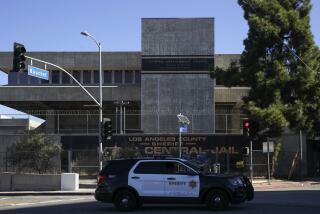D.A. Calls Jails Lethal for Witnesses
- Share via
The Los Angeles County jails can be “dangerous and lethal” for inmate witnesses because jailers fail to take the necessary precautions to protect them, Dist. Atty. Steve Cooley has concluded.
In a report on witness protection, Cooley faulted the Sheriff’s Department for lapses in monitoring telephone conversations, tracking inmates and classifying witnesses who are in custody. He called on Sheriff Lee Baca, who runs the jails, to find better ways to protect inmate witnesses.
“Enough is enough,” Cooley said in an interview Wednesday. “We’ve studied it. We’ve talked about it.... Let’s turn this into action.”
A task force of prosecutors and residents appointed by Cooley evaluated witness protection after a series of killings and assaults. Five inmates were killed at the jails over six months, including Raul Tinajero, who was allegedly slain by the accused killer he had testified against. Had some of the committee’s “common sense” recommendations been implemented earlier, the assaults and killings may have been prevented, Cooley said.
The 32-page report, to be released today, stated that witnesses, both in and out of jail, face more frequent and violent retaliation for agreeing to cooperate with law enforcement. If witnesses are too fearful to come forward, Cooley said, the justice system and public safety suffer.
The Sheriff’s Department should establish a Witness Protection Unit, which would be exclusively responsible for identifying, classifying, housing and transporting inmates who need protective custody, the report said. No cost estimate was given.
Baca called the report “straightforward” and “sober” and said the recommendations echoed what he already knew should be done. A separate unit would be worth considering, he said.
Baca, who is trying to persuade county voters to raise taxes to support law enforcement, said he hoped to make some changes quickly. “It can all be traced to money,” he said. “Without proper funding, the whole report is not going to be implemented overnight.”
The report also recommended:
* Installing equipment to monitor and record telephone calls and visits. Jailers do not regularly monitor public phones, even though inmates have virtually unlimited access to them. The report concluded that the lack of monitoring allows inmates to intimidate witnesses, create false alibis, deal drugs and fabricate evidence.
* Housing endangered witnesses in facilities separate from the general jail population, such as the sheriff’s substations or city jails. Those inmates also should be transported separately and kept in separate court lockups to prevent witness intimidation and dissuasion.
* Improving the existing system by which wristbands are electronically scanned to monitor inmate movement. Scanners should be used at all checkpoints on every floor. The wristbands should also include more information about the inmates, including where they are allowed to be within the jails.
* Using civilians instead of inmate workers, wherever possible. The trusties should be escorted to and from work sites and should not be assigned to areas where they may have access to inmate information.
The task force also suggested that the county Board of Supervisors establish a subcommittee to address witness protection and that the grand jury monitor how the recommendations are put into practice. Task force member Scott Mattingly, a former prosecutor, said he hoped the Sheriff’s Department followed the recommendations.
“It goes beyond cost,” Mattingly said. “It is so important for the integrity of the system that witnesses in custody and out of custody
Other members included former U.S. Treasurer Rosario Marin and former KNX-AM General Manager George Nicholaw.
More to Read
Sign up for Essential California
The most important California stories and recommendations in your inbox every morning.
You may occasionally receive promotional content from the Los Angeles Times.










